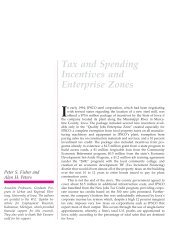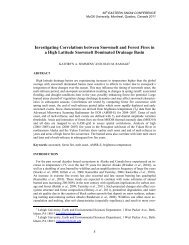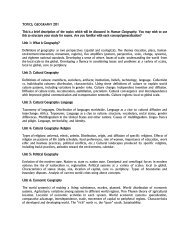PEOPLE ON THE MOVE - Department of Geography
PEOPLE ON THE MOVE - Department of Geography
PEOPLE ON THE MOVE - Department of Geography
You also want an ePaper? Increase the reach of your titles
YUMPU automatically turns print PDFs into web optimized ePapers that Google loves.
Materials &<br />
Handouts:<br />
• Why People Move<br />
• Teacher Background<br />
• Push Factors<br />
• Pull Factors<br />
Suggestions for Teaching the Lesson<br />
Opening the Lesson<br />
1. Explain to students that people move for specific reasons and they will be able<br />
to discover some <strong>of</strong> those reasons. Have students brainstorm some <strong>of</strong> the reasons<br />
that people have for moving from one place to another. Write the responses on<br />
the chalkboard or overhead.<br />
2. Ask students to indicate whether or not their families have moved during their<br />
lifetime. What were the reasons? Some students may need prompts. The<br />
worksheet Why People Move may help focus discussion. Add these reasons to the<br />
list on the chalkboard/overhead. Plot the locations <strong>of</strong> student moves on a map <strong>of</strong><br />
your community, Texas, the United States, or world.<br />
3. Explain to students that reasons for moving can be categorized into push<br />
factors and pull factors. Push factors represent perceived problems or<br />
dissatisfaction with the place in which people are living. Pull factors represent<br />
perceived benefits <strong>of</strong> the place to which people are drawn. Have student<br />
categorize reasons in the list they have generated as either push or pull.<br />
4. Have students summarize (generalize about) the reasons for movement <strong>of</strong><br />
people from place to place. Statements such as, "People move from areas <strong>of</strong><br />
unemployment to areas where jobs are available." is a good example <strong>of</strong> a<br />
summary statement.<br />
Developing the Lesson<br />
5. Using maps and graphs available in many US history texts or world atlases,<br />
help students to understand that historically the US has been the recipient <strong>of</strong> large<br />
numbers <strong>of</strong> people from other parts <strong>of</strong> the world, that many countries have<br />
contributed to this flow <strong>of</strong> people, and that the movement has varied in size from<br />
time to time. Distinguish between immigration and emigration.<br />
6. Help students hypothesize about push and pull factors that might have been<br />
operating for specific groups at specific time periods, e.g., the Potato Famine,<br />
Ireland, 1840s, Industrial Revolution and Enclosure, United Kingdom, mid-<br />
1700s, revolutions and military conscription in the German states, 1840s and<br />
1870s, pogrom in Russia, 1890s, Mexican Revolution, 1910s-1920s, conflict in<br />
Central America, 1980s, etc. Ask student why their families emigrated to the<br />
United States. Have them interview their grandparents and relatives. Map their<br />
routes.<br />
7. Hand out the documents Push Factors and Pull Factors. Explain that these are
















